The Western world is an ancient system that repeatedly fails to reform itself. That place where the human quality will be experienced as simply as it should be is probably the African continent itself. What cannot be avoided, is for Africans to be referred to , not simply as humans, to quote Hannah Arendt, but as something necessarily different. Westerners, it appears still need this exoticization in order to justify the growing number of ”third world” artists entering the market and potentially taking sales from traditional European aesthetics. But this market is only interested in what is already known and that can be labelled and categorized. Its the Christopher Columbus complex involving the need to discover and then recognize involving a partner willing to sacrifice themselves for this type of useless noise.
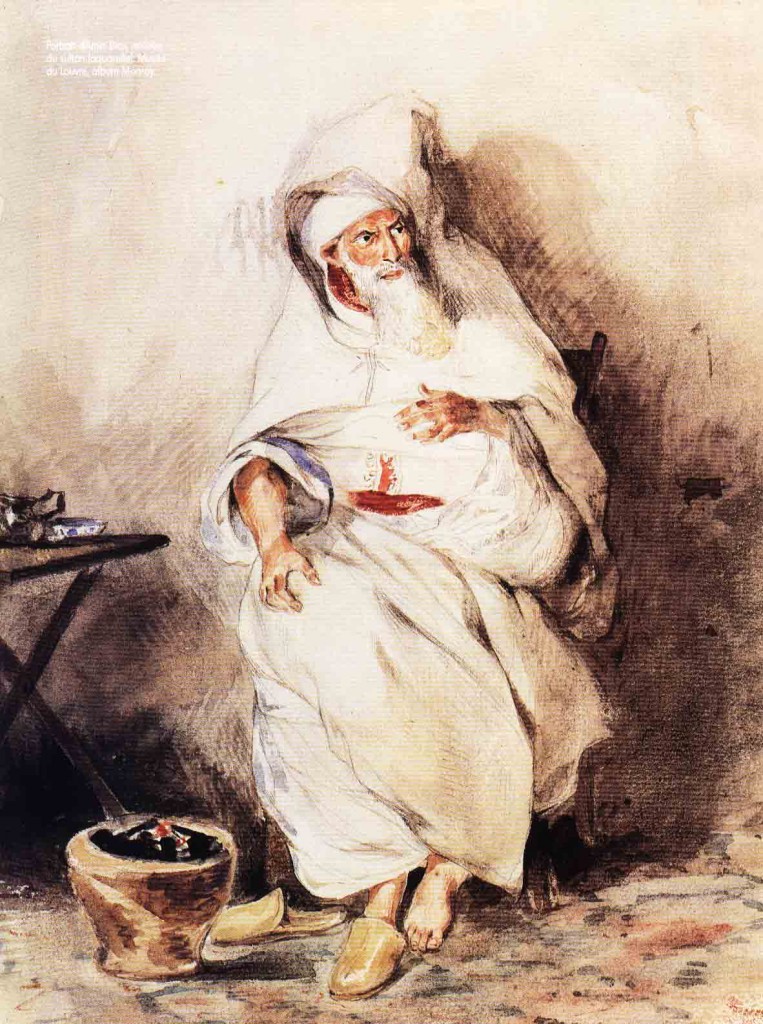
Delacroix's portrait of Amin Bias, Tangier's minister of customs, was part of the album of watercolors he presented to Mornay at the end of the trip
Alongside the exogenous image of ourselves that threatens to encircle and encloses us in archetypes, there is an endogenous image that seeks to blossom forth, to express what Delacroix called the ”chaotic world of sensations” For, if language has meaning, it is that. But how can one transform chaos into a structured and equilibrated whole and then translate that world into the reality of a visible representation that is at least somewhat attached to the notion of coherence. The problem of the ”us” and its representation appears to be an enigma with resolution. An infinite problem of group and individual, each with their own grievances.
In 1832, a diplomatic expedition to Morocco took along Paris’s most dashing young romantic painter, Eugene Delacroix, to record its imperalist triumph. The result was much gunfire, a minor treaty, and a turning point in nineteenth century art. His role was history painter attached to the diplomatic mission of Charles de Mornay. Delacroix, at thirty-three was not yet the monkish, complsive worker he became in later years. Nor was he the messy Bohemian sort of romantic. He was an appeaser of the establishment with well tailored clothes, aristocratic manners and a classical education.
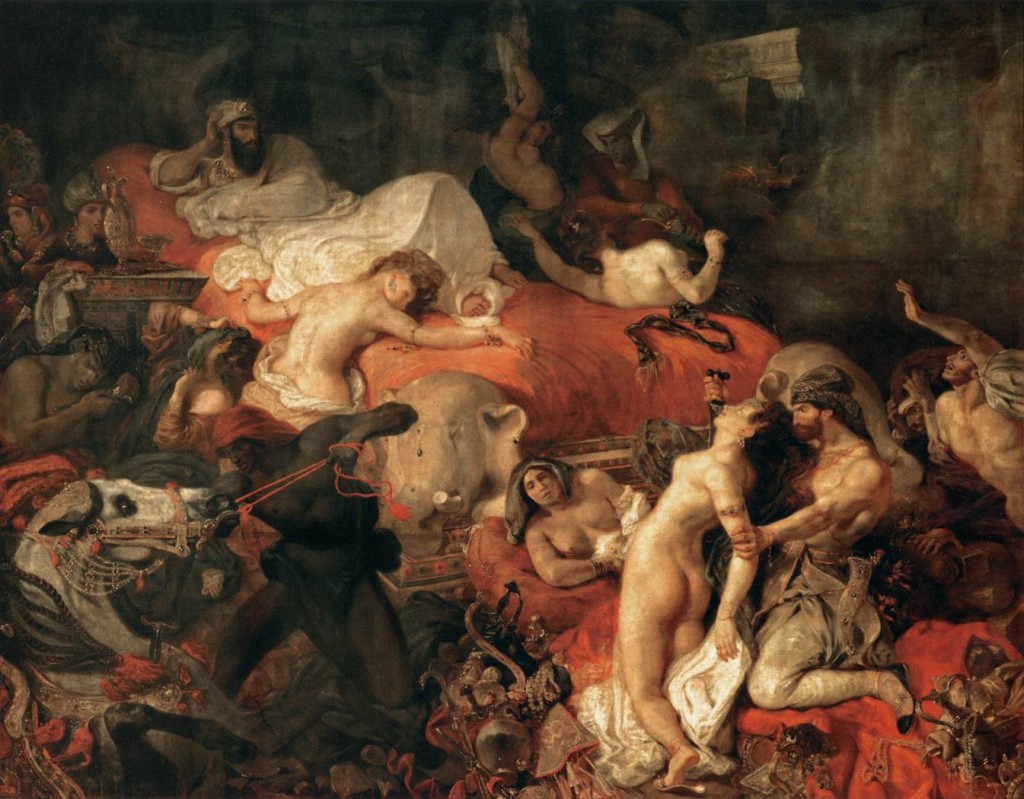
''The various aspects of Romanticism come together in Eugene Delacroix’s Death of Sardanapalus (1827). The painting is based on the play Sardanapalus by Lord Byron and depicts the death of the king Sardanapalus. On first glance, the painting causes uneasiness in the viewer that is difficult to articulate. The scene is both chaotic and confusing. Women and servants are in poses of great distress as they are being killed on the king’s orders. In particular, the execution of the nude woman in the lower right hand corner of the painting elicits a range of emotions from the viewer. We are at the same time both horrified and mystified. We feel sympathy for her, yet we cannot stop from looking. ''
He was a bit of an ordinary salon poseur. The fierce sexuality in his paintings did not correspond to the celibacy of his bachelor life . One of his finest pictures, ”Liberty Leading the People” (1830) was basically political make-believe , for in fact street insurrections filled him with bourgeoise anxiety and alarm. His ” Death of Sardanapalus” ,a splendid rhetorical work, had been nourished on Byron and an Eastern exoticism fueled by Turkish bric-a-brac.In sum, he had been living and creating largely on the basis of secondary sources and feigned and imagined feelings. Now he was confronted with the prospect of sunlit primary sources and violent physical sensations.
After landing at Tangier, they waited for the end of he Ramadan fasting, then set out on horseback, with camping equipment and a Moroccan escort for Meknes, the imperial city, about 300 kilometers south. It was exotic.Delacroix’s diaries excho with the roar of massed explosions and the whistle of bullets, for the Moroccans were inclined to fire their long guns on almost any pretext: as a sign of welcome, as a way of impressing infidels, as an addition to the excitement of a horse race or simply as an expression of high spirits: ”At each instant we met with new armed tribes that expended gunpowder at a frightful rate to celebrate our arrival…From time to time we could hear a stray bullet hissing in the midst of the rejoicing”.
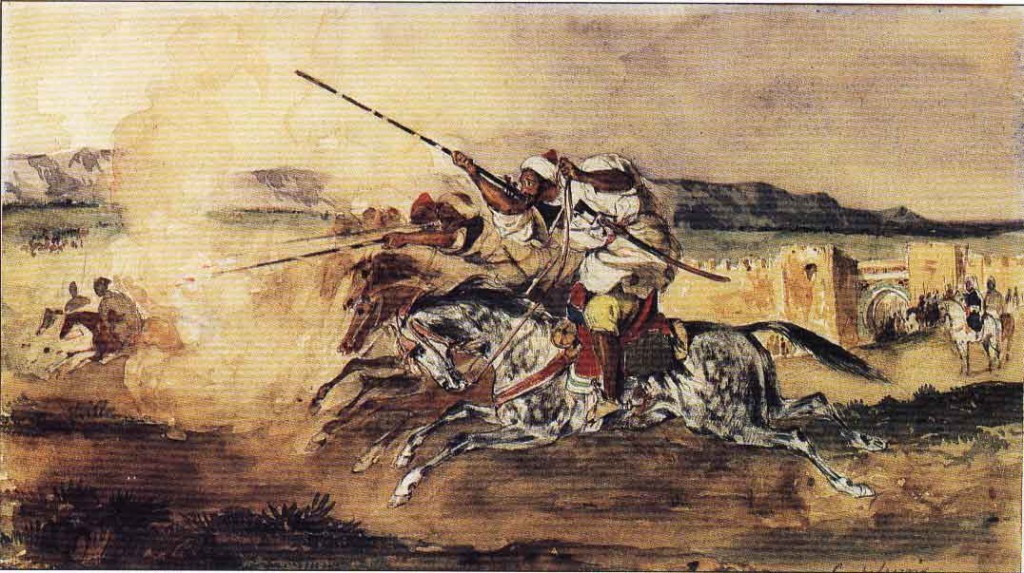
Delacroix; a display of the shooting near the gate of Meknes, a raucous form of welcome given to the French mission by the Sultan of Morocco's warriors was set down by Delacroix for Mornay's album. For the rst of Delacroix's career, mounted warriors would figure more and more often in his paintings.
The simplicity and the immutability of Moroccan life turned him, for the time being at least, into a disciple of Rousseau. Accoding to his sketchbook, ” We notice a thousand things that these people lack. Their ignorance of such, makes them calm and happy. Are we ourselves at the end of what a more advanced civilization can produce? They are closer in nature in a thousand ways; in their clothes, in the form of their shoes. Hence beauty is linked to everything they do. In our corsets, our tight shoes, our ridiculous sheaths, we inspire pity”.
Art cannot exist without an embodiment of some kind. The body becomes the place of narration, the personal body as well as the social body, the body of the other. The perception and comprehension of Delacroix resulted in the body ceasing to belong to its owner, and becming a metaphor of an ”us” that the viwer has to apprehend. It becomes matter. And in Delacroix’s North African work, this matter was not detoured far from its original meaning. That is, the visual representation avoided conventional images of racial typologies whose substance arose from the dissociation from cliches. It is soul that ties together the contradictory question of perception; that masters the divided object between what is sent out and what is perceived. Perhaps the right conclusion is simply that Delacroix, without breaking the continuity of his art, did some intensive ripening during his time away from France. In a letter from Tangier he said as much, ”In this short while I have lived twenty times more than in several months in Paris”.
Delacroix’s African experience is what could be termed the ”being-in-the-world”, the realm in which we project ourselves as we would like to be seen in this space. Delacroix negotiated the conditions of his humanity and avoided the trap that condemned Narcissus. He was able to deconstruct a politicized colonial history; and reactualize an embodiment of myth and culture devoid of contemporaneity and into a realm, a world, that Delacroix was unaware of. There was a questioning of the fixed image and a reflection on its place in the world in which the artist faces both inward and outward at the same time.
That is the divide to which Jean-Paul Sartre refers in quotation in which the term ”black” must be understood as non-white or colonized. ”The herald of the black soul has attended white schools, in accordance with the pitiless law which refuses all weapons to the oppressed except those that he steals from the oppressor; the clash with white culture has made his negritude pass from immediate existence to a reflected state. But at the same time he has more or less ceased to live it. In choosing to see who he is, he divides, he no longer coincides with himself” ( Sartre, Orphee Noir )
An Algerian gave Delacroix permission, under a vow of strict secrecy, to visit his harem, a visit that the artist blazoned before Paris two years later when his ”Women of Algiers” was exhibited at the 1834 Paris Salon. This romantic masterpiece of muted complementary colors was based on pencil and watercolor sketches made during his harem visit. He is said to have been bedazzled when he saw ,” woman as I understand her, not thrown into the life of the world but withdrawn to its heart as its most secret, delicious and moving fulfillment.”


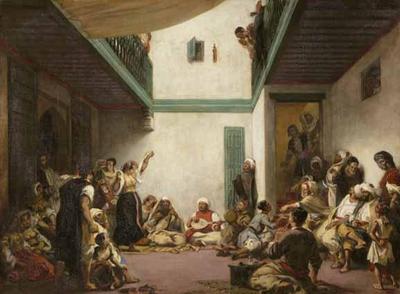
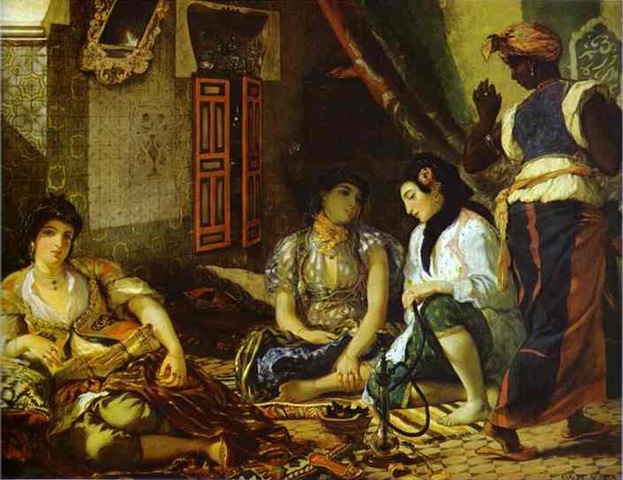


 COMMENTS
COMMENTS
I read all your articles, you consider very interesting themes.
Happy New Year Dave.
Thanks for reading. Its good to have comments; to touch base a bit with the readers. Subjects are often not the ”hot trendy” topics, but there is a a lot of resonance out there for this blog, given the short time it has been up. Best,Dave
awesome!!!I’m a fan of Delacroix’s